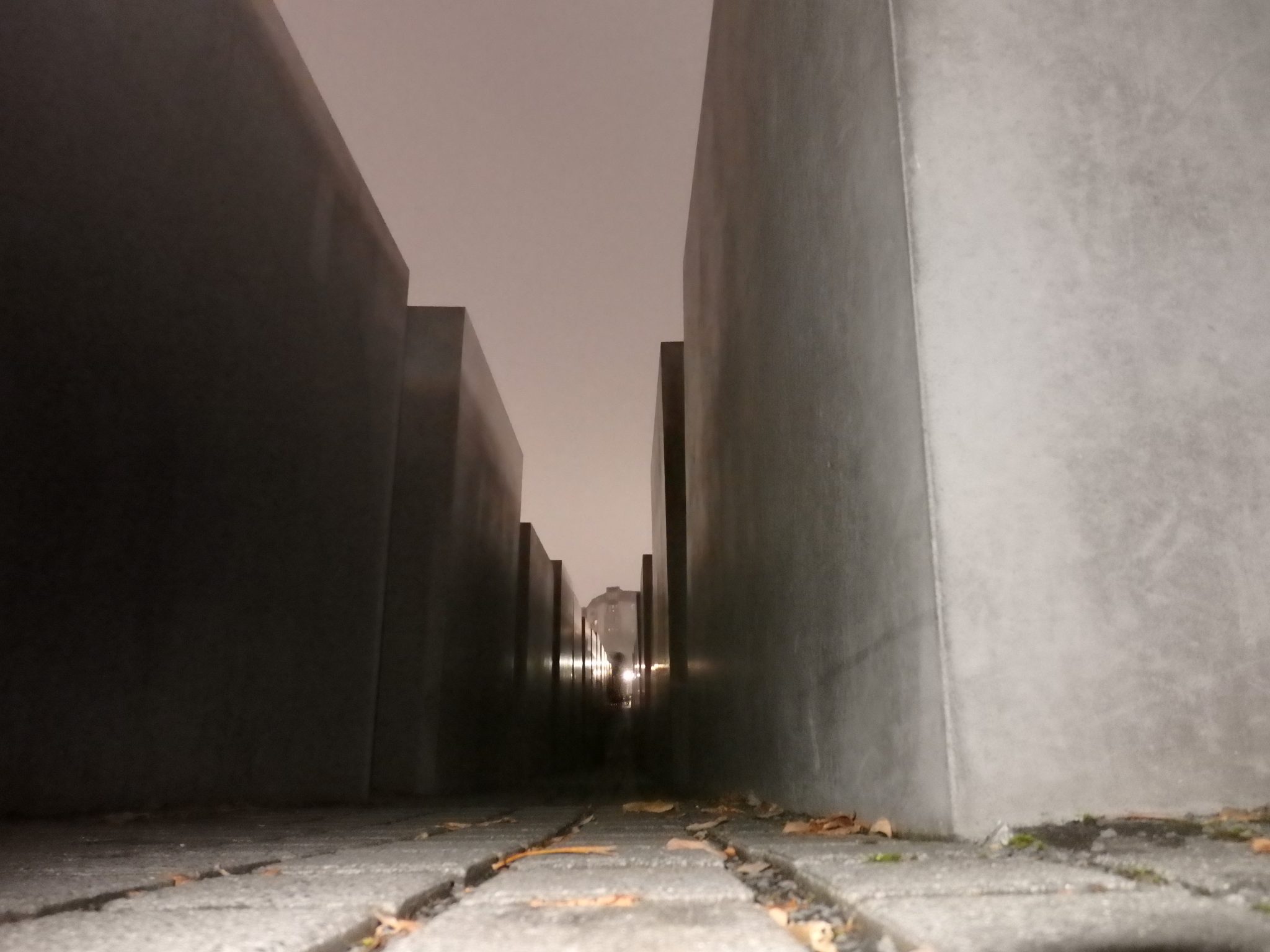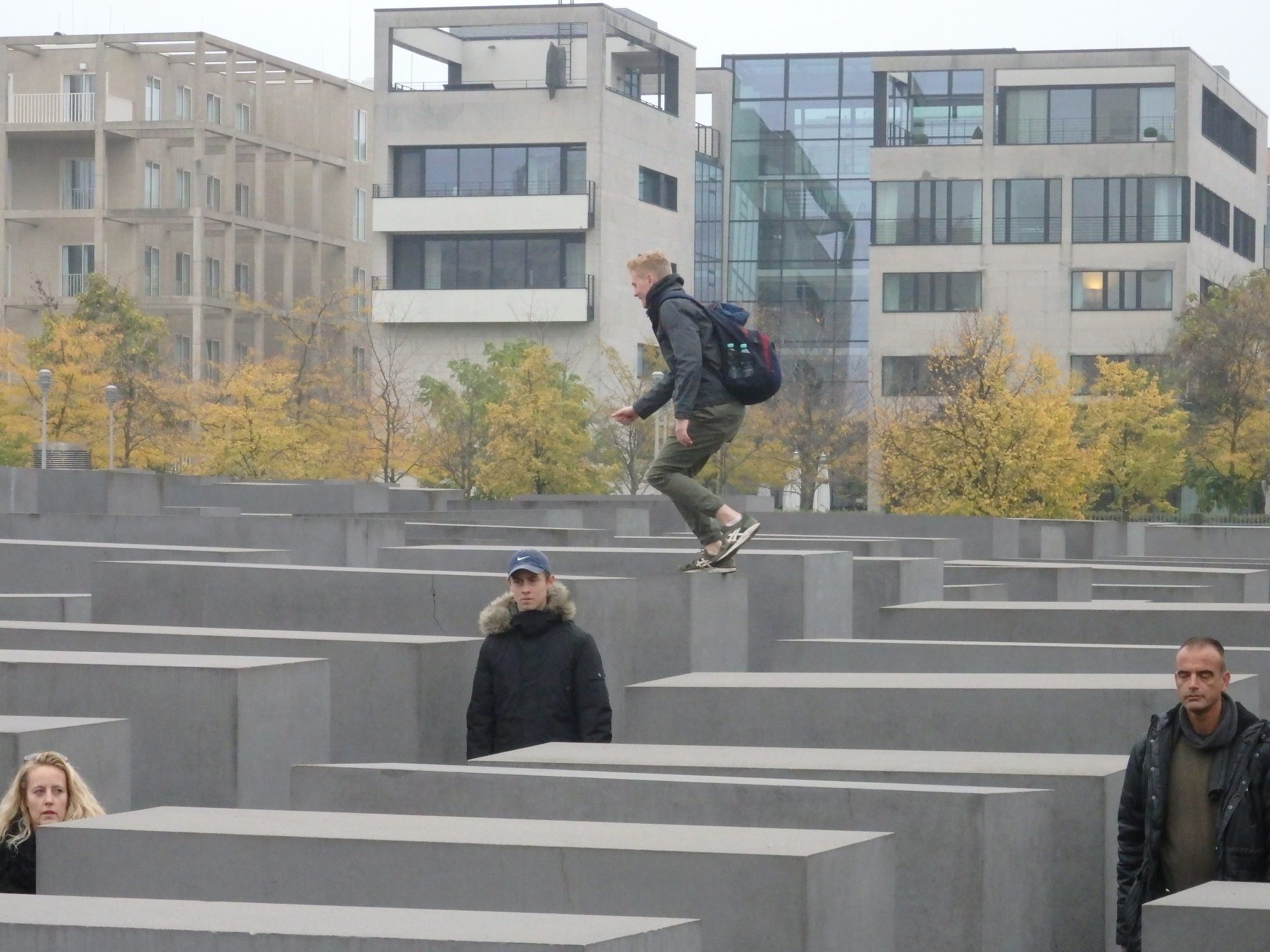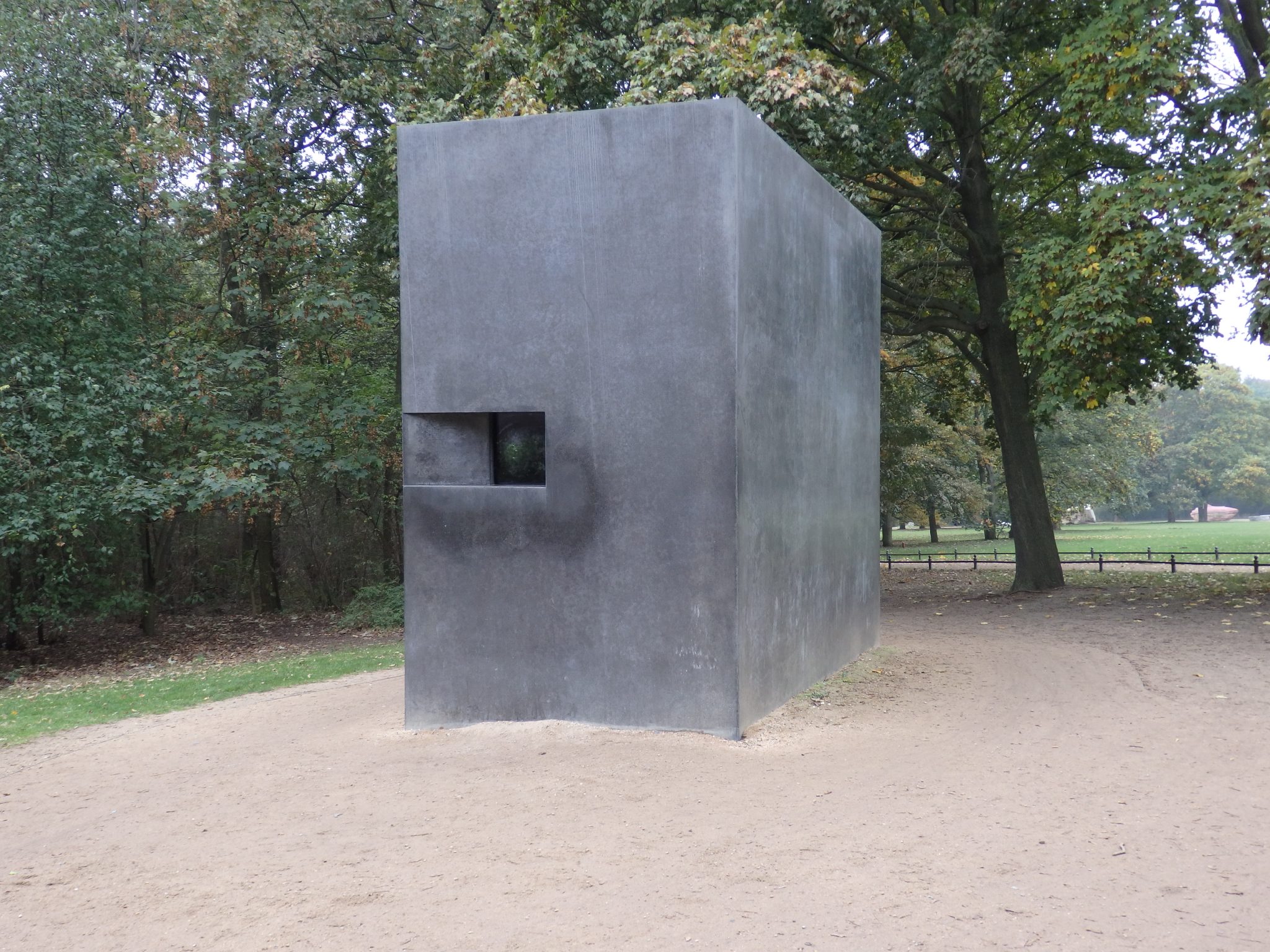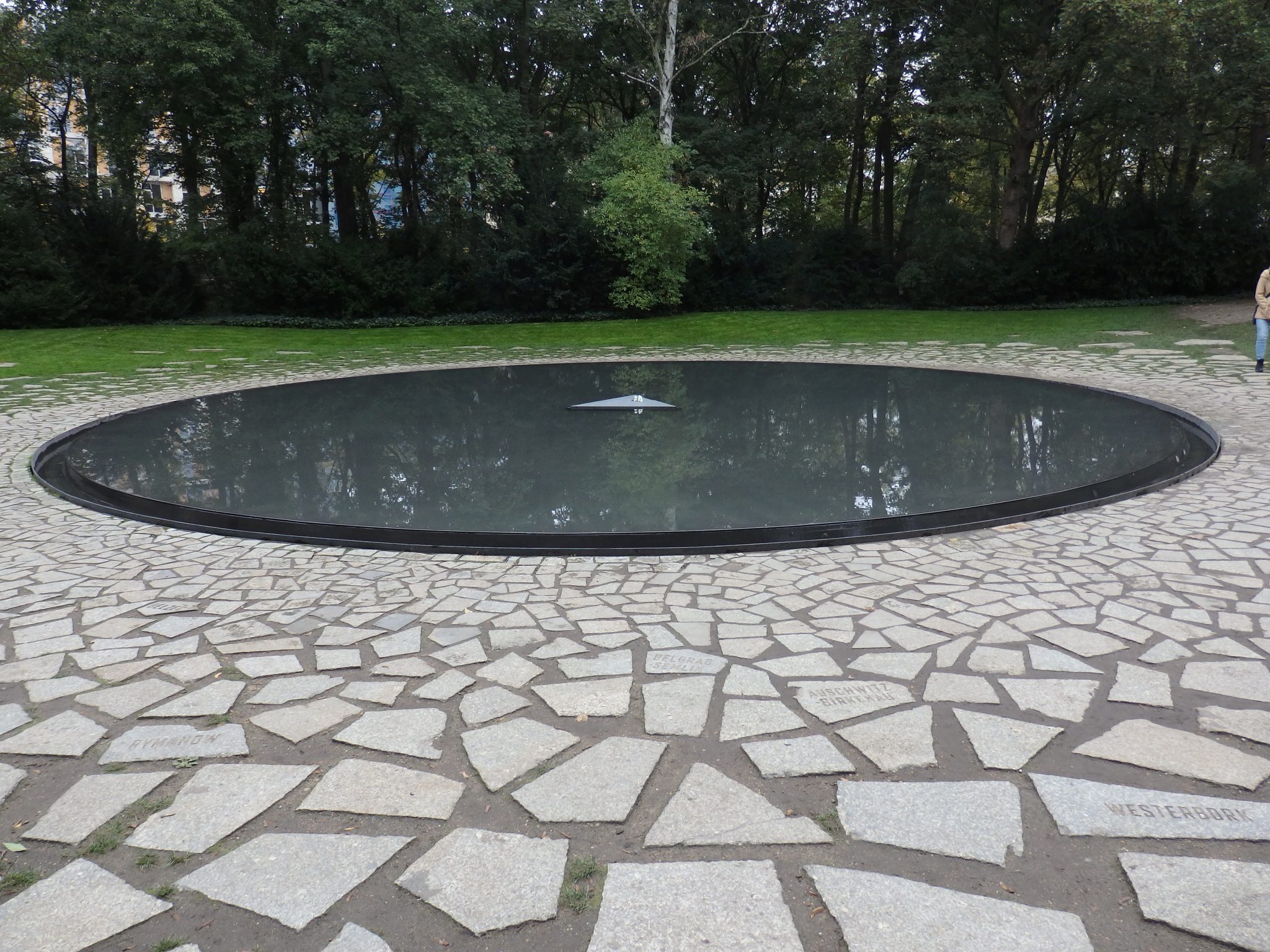The Memorial to the Murdered Jews of Europe in Berlin
The night I arrived in Berlin was full of color and light: the annual Festival of Lights was underway. A light show projected onto the Brandenburg Gate kept the crowds entertained in the cold autumn air. Walking the short distance from the Brandenburg Gate to the Memorial to the Murdered Jews of Europe meant, both literally and figuratively, walking from the light into the darkness.

The Memorial to the Murdered Jews of Europe is a full city block in size, filled with smooth concrete blocks in neat rows. All are the size around of a grave, but instead of extending down into the earth, they rise up from it. Ranging from knee-high to perhaps three meters, they grow taller toward the middle of the block. At the same time, the uneven ground descends.
Nighttime at the Memorial to the Murdered Jews
The memorial was completely unlit. Knowing from photographs what it looks like in the daytime, I was nevertheless taken aback at this hole of darkness surrounded by the bright city.
As I approached, I saw that people had entered the memorial, though most stayed at the edges, where the concrete blocks are low.

Moving closer, I realized that people – mostly children, but also some young adults – were climbing on the concrete blocks, laughing, jumping from block to block in the dimness.
The wave of anger that came upon me – warming my face, churning my stomach – took me by surprise. I froze and stared at the nearest family, whose son was happily jumping between stones. I don’t understand much German, but they did not order him down. It was perfectly all right with them.
I think they felt my stare; they called him down from the stones and walked away. But there were so many more, doing the same thing.
I stood there on the edge of the memorial, tense and still, just watching, pushing back the angry tears that threatened.
Memorials are meant to preserve a memory. The Memorial to the Murdered Jews of Europe should serve as a reminder of what they, the Nazis, did to us, the Jews, with the acquiescence of the German people.
Seeing Germans literally trampling on that memory … the thoughtlessness, the lack of respect, just appalled me.
I tried to fathom why they were treating the memorial this way. A memorial is a place of remembrance. Didn’t they remember? An even worse thought occurred to me: what if they do remember, but just don’t care?
People are sometimes just thoughtless; I know that. They choose expedience over principle. After the light show down the block, maybe their children were all wound up, and letting them climb the stones would help tire them out before bed. I understood that.
I also understood that it wasn’t them who perpetrated the crime; it was more likely their grandparents.
Nevertheless, it still hurt.
I wanted to go up to each and every one of them and point out what they were doing: “This is a memorial for the Jews whom your people killed because we are different from you. Treat it – treat us – with the respect we deserve.”
Gradually, I gave in to the futility of saying anything or confronting anyone. I felt defeated and deflated, but I felt my body come unglued from that spot, and I could walk again.

I ventured further into the memorial, downhill between two rows of stones. I didn’t go very far, since this place of darkness where it would be so easy to hide seemed a perfect place for a nighttime mugging.
Stopping a few rows in from the edge, what I could hear but not see was what sounded like groups of teenagers: flirting, shouting, girls play-screaming.
Complete disregard for the meaning of the memorial.
You might also want to read my article about lots of World War II and Cold War sites in Berlin that you can visit.
Daytime at the Memorial to the Murdered Jews
The next morning I went there again, curious to see if things were different in daylight. I wondered if, in the light of day, people were more likely to be respectful.
They weren’t. During the day, more children jumped from stone to stone, and the adults sat or stood on the stones, taking selfies. I went further into the block in the daylight, noticing the unevenness of the brick-paved ground as it descended into the canyon of concrete. Children played vigorous games of hide and seek, running among the tall stones, calling, laughing, falling, sometimes crying. It sounded like a playground.

I spotted a security guard. I don’t know if a guard was there at night. It didn’t make any difference, though. He didn’t shoo people off the stones, or remind them of the meaning of the place. He just stood there. Apparently using this memorial as a playground is perfectly acceptable.
There is an underground “place of information” at the memorial. I didn’t go in, so I don’t know if it cautions visitors to treat the memorial with respect. It’s ineffective in any case, since people can enter from any side of the block.
Other memorials
I visited two other memorials that day, partly because I’d heard they were interesting, and partly to see how they compared.
Right across the street from the Memorial to the Murdered Jews of Europe is the Memorial to Homosexuals Persecuted Under the National Socialist Regime. A smaller monument, it consists of a huge concrete block, set with one small window. Peering in, you can see a black and white film of two men in a loving moment: one kisses the other sweetly.

The huge box represents the closeting and the fear of being caught that they carried with them, as well as the capture and suffering and deaths of so many by the Nazi extermination system. I thought it an effective, understated memorial.
A group of Germans looked in the window right after me. One made a comment I didn’t understand, and they walked away, laughing.
The Memorial to the Sinti and Roma of Europe Murdered under the National Socialist Regime is also nearby, just opposite the Brandenburg Gate. This is a quieter, less confrontational monument. A long wall inscribed in German and English tells the story of their persecution and extermination.
Passing through the metal entrance doorway, visitors step onto a grassy lawn set with paving stones. Some of the stones are carved with the names of the various camps the Roma, Sinti and other groups were sent to.
In the middle of the memorial is a low flat circular fountain, but designed so that the water looks dark and flows quietly over all the edges. It appears to be a still pond, and the surface of the water reflects the sky. The tiny triangular island in the middle, representing the symbol the Roma and Sinti wore, akin to the Jews’ yellow star, held one white flower.

At the entrance to the Roma and Sinti memorial is a sign reading:
You are entering a place of remembrance. Please respect the purpose and the people for whom this memorial site was created.
This makes sense. Why aren’t similar signs posted around the Memorial to the Murdered Jews?



Ugh. What a dreadful experience. So sorry. I’ve seen people behave dreadfully at memorials before, but that’s the worst. It makes the monument a mockery. . . some education seems to be greatly needed at the site itself. I wasn’t aware of the Roma and Sinti memorial – it looks like a lovely reverent space.
Yes, it needs people or at least signs on all four sides all along the block!
I’ve been there a couple of times and it’s always like that. I think the whole thing is weird. Bordered on one side by the US embassy and then the other side with the park and the other 2 memorials where people are living their daily lives. And, the concrete columns don’t give the impression that you should either be reverent or thoughtful. The Holocaust Museum in Berlin is much better which is a shame because most people pass this Holocaust Memorial.
There’s another Holocaust memorial in Berlin? Where is it?
Hi Rachel. There is another museum in Berlin called the Jewish Museum Berlin. It was designed by the architect Daniel Liebeskind. If you get back to Berlin you definitely have to go there.
Yes, I did go there, and wrote about it here: https://rachelsruminations.com/jewish-museum-berlin/
The people who allow their children to “play” inside of a memorial are the very same ones who will later complain that “young people have no respect” or some such drivel….all the while supporting & encouraging the unacceptable behaviour. The adults who do this? Low-lives.
I can understand your anger as well as disbelief that people would behave so thoughtlessly at the Memorial to the Murdered Jews of Europe memorial and even use the place as a playground. Obviously the symbolism has been lost on what should be a place set aside for reflection and remembrance of the people persecuted and killed. I agree that a sign reminding people of the purpose of the memorial is needed. Your post makes me feel sad and disheartened about those who can’t or won’t learn respect for others – in the past and now the present.
In this case it would have to be a whole series of signs all the way around the block. It is disheartening indeed, both that people use it this way and that nothing is done about it.
Hi Rachel. I’m so sorry you had this experience. It is very clear that the memorial should have signs at each place of entry or a large sign on each side that explains this is a place of reverence and that violators will be prosecuted. If I were you, I would either write a letter to the Berlin Tourism Department, or better yet, send them a copy of your post and indicate that you are an international travel writer who was troubled by this experience. It would be interesting to hear their response.
Hmm. Perhaps I will.
This is very sad. There should be security staff as in most museums who monitor visitors and don’t allow anyone to behave in this way. As an educator I’m shocked at the disrespect and entitlement I witness in children and teens at home and abroad every year. Parents allowing their kids to use this Memorial for a playground is disturbing but given many set no boundaries so someone else I guess will have to enforce decent behaviour. I agree you should share your post with the Berlin Tourism Department.
Yes, I suppose I shouldn’t have been surprised.
Such a complex history and it’s hard to impress the young with that. We need to remember, but to embrace survival and triumph of spirit over what happened. Perhaps those young revelers are the spirit of the slaughtered finally laughing and enjoying life. I am not Jewish but once married into a Jewish family that wanted nothing but to leave the old country behind (they fled the Pogroms), yet embraced remembrance through ritual – lightly. Thank you for sharing.
That’s a nice way to think about it. I fear, though, that they’re not remembering at all: either the parents or their children.
I used to live in Berlin and I ve seen this memorial a lot, and just like you I didn’t like the fact a lot of people are jumping on it! I am guessing they dont know that it is a memorial or they just ignore it ! There is security but one guy can’t control everyone. Did you go to the museum there hidden underground ?
No, I didn’t go to the information center. I was feeling pretty disgusted with the whole place, and I do know the history. The thing about the security guard I saw, though, is that he wasn’t even trying to control anything! He was just standing there watching everyone jump on the stones.
The Memorial struck us as a bit odd. Perhaps the scale of it takes away from the reverence, although it shouldn’t. Also I think people just get too used to something that they see everyday in their hometown, but that doesn’t make their disrespect alright. At least while we were there a security guard did tell a few people not to climb on the blocks.
It’s good to hear that the security guard was at least supposed to chase people off!
I’m so sorry for your distress Rachel. I live in Berlin and know this monument well. There is no excuse for disrepect of this horrible event, and the lives of people who were murdered or passed away. Whenever I was there, security and random people and visitors told children not to stand on the stones…
I have always endeavoured to explain to my son the seriousness of the attempted Jewish extermination in Europe. Indeed, as a young child, I used to take him to cemeteries where we would look for names and families, and stand in silent contemplation.
Indeed, as he’s half-German and half-British, I make it my duty to take him on Jewish walking tours and in fact, since we live in Prenzlauerberg and we’re one stop away from Mitte, Jewish history and culture is all around us. In fact, we’re within 10 minutes walking distance of Rykestrasse Synagogue – Germany’s largest synagogue built in 1903/1904.
I can’t tell you why more care is not taken, but I can tell you the Jewish monument that gets it right – the Jewish Museum in Berlin – https://www.jmberlin.de/en. Security is extremely tight there, and there is security all around, and most importantly, guides and helpers to steer people on the right way to do things. There is a sense of seriousness and love for the Jewish people, Jewish culture, and Jewish history.
There are many Jewish monuments and memorials in Berlin which are well visited and given the respect that they are due, and they are not going away anytime soon.
Yes, I went to the Jewish museum as well, and I will write about that visit in a few weeks. (I still have some Spain posts from the summer to go up first.) That museum is a memorial too, and is very respectful and powerful.
Rachel, I can understand your feelings (and can talk about this topic for a long time but I’ll try to keep it short).
I went to Auschwitz about two months ago. The experience got me thinking a lot (till this day). However, I got a little bit furious with the behavior of certain people. First, there were the people who were talking loud, screaming and laughing in the closed areas. At some points, it was difficult to hear our tour guide (even though we were listening to him thru headphones).
Then, there were the people taking selfies in the barracks, in front of the barb wire, etc. Plus, people sexy posing for pictures over the train tracks or other places. That really made me mad.
A lot of people do not care about these (or other) historical events. Sounds harsh but it is the truth.
At Auschwitz?! I don’t get why they’d even go there if they have no understanding of what happened there.
Hi, Rachel. I got angry just reading your post. I can’t imagine being there! I’ve seen this a lot at the temples in SEA. Most temples will have signs and photos indicating how people should dress, but many take no heed. I’ve seen people run their hands down over ancient murals. Why? I’ve also encountered people smoking on temple grounds. Why? Honestly not sure how a lot of people think these days. I will say though that I didn’t see bad behavior at either Nagasaki or Hiroshima. I don’t think the Japanese will put up with disrespect from visitors.
BTW, your photos are beautiful
Thanks for hosting this week. #TPThursday
Thanks, Nancie! Hard to understand how people can be so thoughtless.
It’s too bad you had such an experience. I’ve been to the memorial a few times, all during the day, and each time there would be people climbing up on the pillars and security guards and other visitors would tell them to get down. I agree with you, this really shouldn’t happen and putting up signs really would take away from the atmosphere (they would need to put too many signs to have any effect).
I don’t think putting up signs would take away the atmosphere. They’d have to be reinforced by security guards and/or volunteers, but the signs would make it less acceptable to play on the memorial.
It’s very sad that the city doesn’t make sure there is surveillance to prevent this type of thing. We were at the memorial several years ago and didn’t witness this. I’m so sorry you did.
That is such a shame that a memorial is treated with so little respect. They really do need to put signs up for those who are clueless and enforce it for those who are intentionally disrespectful. I wonder why they do not light the memorial at night. Is it symbolic of the darkness — both literal and figurative?
I suspect that that is the reason. I don’t mind that. I just minded how it was being used.
I completely understand your shock and disgust and have experienced similar behaviour during my last visit to Berlin (moi being Dutch, living in Hamburg since 2013). Please note, however, that it’s generally not the Germans frolicking about the memorial, but mainly tourists who do so. Berliners themselves are disgusted by this behaviour as well and have voiced that disgust all over the internet.
One could also blame the architect for the behaviour. People react to the environment built around them. I visited the museum in December 2019 and saw similar activities but luckily there were a couple of a security guards who reacted.
Yes, true. I suppose there could have been design elements that would discourage that behavior. Not sure what, though, since fencing or similar has symbolic power as well. I just wish people would show respect of their own accord…